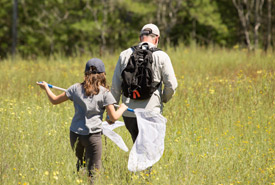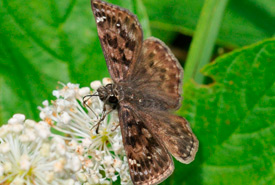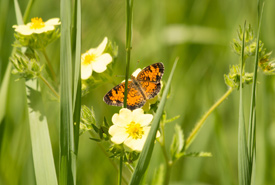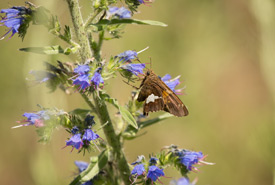Chasing butterflies on the Rice Lake Plains

Catching butterflies on the Rice Lake Plains, ON (Photo by NCC)
A hike through the tall grass prairie and black oak savannah habitats of the Rice Lake Plains in Ontario may lead to discovering a vibrant, quiet and critical player in grassland conservation: butterflies!
The surprisingly adrenaline-filled activity of viewing, identifying and counting these fascinating insects can leave a lasting impression on your perspective of the natural environment. This summer, the Nature Conservancy of Canada (NCC) hosted a Conservation Volunteers (CV) butterfly count to document butterfly abundance on the Rice Lake Plains.

Mottled duskywing (Photo by Wildlife Preservation Canada)
On a hot Saturday, a group of more than 40 passionate CVs met at the Alderville Black Oak Savannah Nature Centre for the annual Rice Lake Plains Joint Initiative Butterfly Count.
After a brief event overview from Val Deziel, NCC’s assistant conservation biologist for the Ontario Region, six teams diverged across the Rice Lake Plains Natural Area to search woodland, savannah and prairie habitats. Many of the areas explored over the course of the day are properties owned and cared for by NCC and our partners.

Northern crescent (Photo by NCC)
Groups searched for butterfly species that have historically been found in the Rice Lake Plains area, such as the provincially endangered mottled duskywing butterfly. Added to the Species at Risk in Ontario list in 2014, this member of the skipper family is threatened by habitat destruction. Mottled duskywing lays its eggs on two plant species, prairie redroot and New Jersey tea. Emphasis was given to searching around these types of vegetation, and one team in particular observed 23 mottled duskywing individuals throughout the day — a truly special opportunity!
From experienced butterfly specialist to enthusiastic butterfly catcher, there was something to learn for everyone at this event. More than 1,700 individual butterflies were observed throughout the day, including monarch, red admiral, wood nymph, eastern tiger swallowtail, silver-spotted skipper and northern crescent. Taking the time to pay attention to the presence of different species and their unique habitat types provides biologists with insight into effective stewardship initiatives. Interacting with various species was rewarding and valuable to the overall effort of the butterfly count.

Silver spotted skipper (Photo by NCC)
There are several benefits to looking for butterflies that can positively impact their conservation status. By searching, you’re contributing to the environmental monitoring process. Butterflies are pollinators and are critical to the success of the native vegetation that makes up the Rice Lake Plains.
Protecting butterfly populations through habitat protection is one part that you can play in helping support Canadian species and landscapes. The instant gratification of finding and observing a butterfly, like those on the Rice Lake Plains, is sure to inspire you to keep exploring and protecting nature into the future. To keep up to date on future CV events, visit conservationvolunteers.ca.


